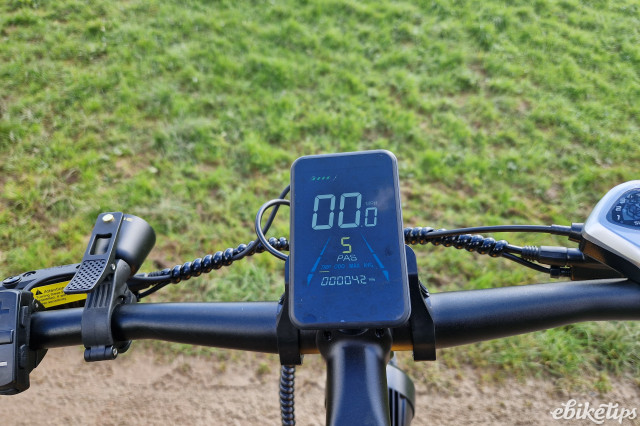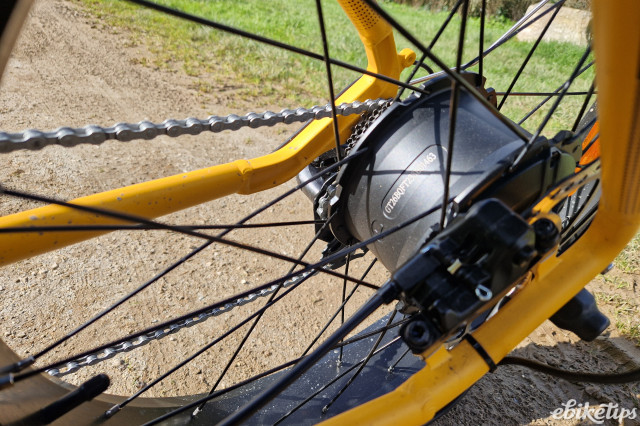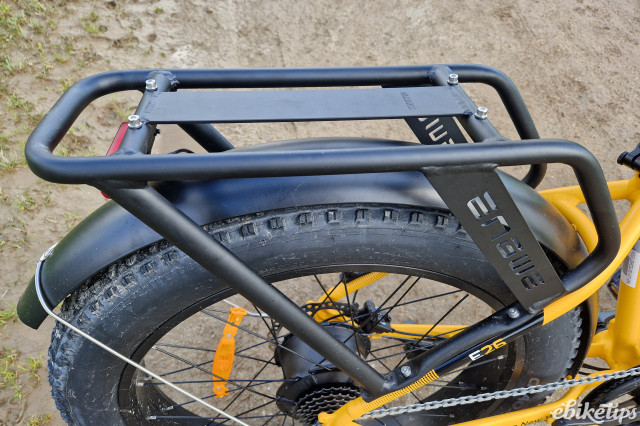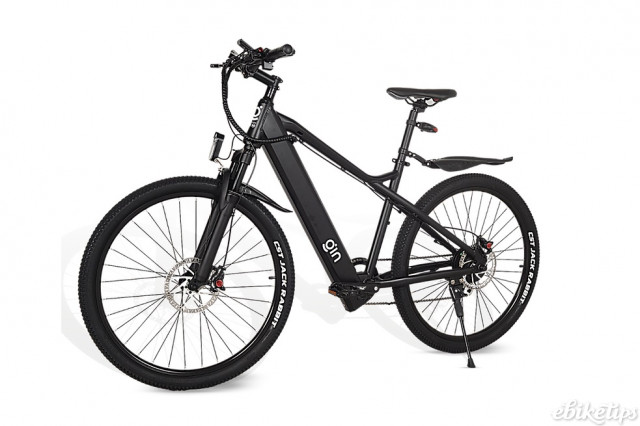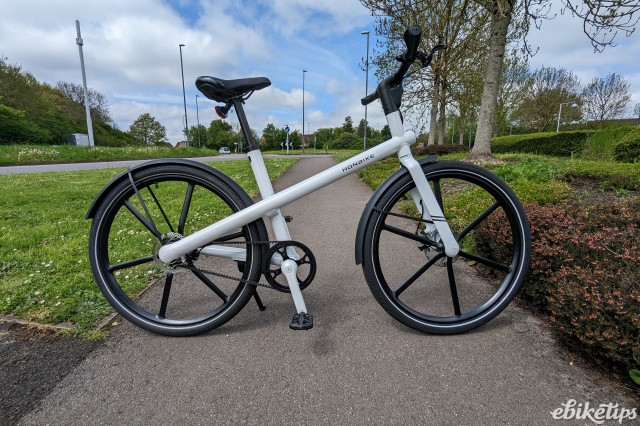Review: Engwe E26 ST
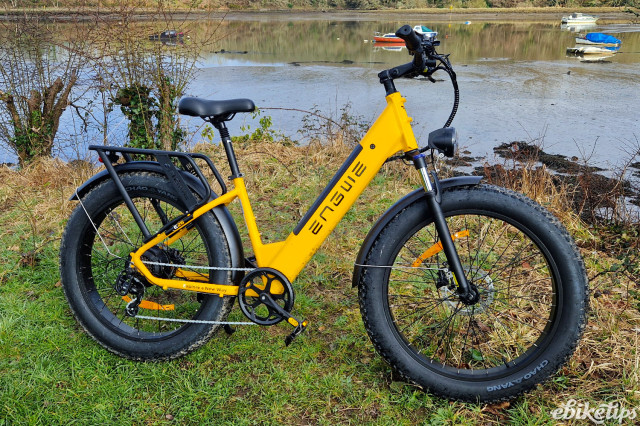
Overview
- Smooth and powerful motor
- Comfortable riding position
- Cargo carrying potential
- Very big and heavy
- Only two usable pedal assist levels
- Sluggish handling at low speed
Hardly a week goes by without a new fat-tyre e-bike being released in the UK. These two-wheeled behemoths often weigh over 30 kilos and have energy-sapping 4-inch tyres. The Engwe E26 step-through is such a bike, featuring a 250W hub motor, a 768Wh battery, and dimensions more akin to those of a small motorbike. Over the last few weeks, I’ve been testing it to see if it’s practical as a daily form of transport.
Engwe is one of the brands that originally made its mark in the US before coming to our shores. Most of their e-bikes are big and heavy, but that doesn’t seem to put consumers off, and they have become quite popular here.
The sheer size of the Engwe E26 was evident when it was delivered (by two men). The box was so big and heavy that I couldn’t take it down the narrow stairwell to access my backyard. I ended up having to assemble it in the confines of my upstairs hallway (much to my wife's amusement).
It was very well packaged, and removing all the foam and cable ties was a job in itself. Assembling the bike required fitting the handlebars, front wheel, mudguard, kickstand and fixing the pannier rack in place. The bike came with all the necessary tools and fixings required for the job, and the instructions were relatively easy to understand. However, if you’re new to e-bike assembly, I’d be inclined to get the help of a mechanically-minded friend or qualified bicycle mechanic.
Once I’d shoehorned the assembled bike through my front door, I took it for a spin in the rain. Not having ridden a fat tyre e-bike for a while, I’d forgotten how heavy and ungainly they can feel (the experience is akin to riding a two-wheel tractor). With the motor in the highest power setting, I headed off.
There is an initial delay from the cadence-sensing pedal assist, followed by a big surge in acceleration that quickly takes you to the 15.5mph assistance limit. Beyond this, there’s no seamless transition - when the motor cuts out, the going gets tough. The weight and big tyres severely hamper unassisted progress.
There are five levels of assistance, but anything below level four is useless. The motor cuts out at the following speeds: 4mph (level 1), 6mph (level 2), 8mph (level 3), 12mph ( level 4), and 15.5mph (level 5).
I’ve no idea why the pedal assist system is configured this way, and it’s not the first time I have encountered this on an e-bike. The only merit I can see is if you’re negotiating obstacles at a slow speed.
For general riding, you need to use level 5, which means maximum power consumption. There is a half-twist throttle fitted, but it’s disabled. I found that a little odd, as throttles can be legally used up to 6km/h.
The handling feels sluggish at low speeds, particularly when navigating bollards or tight turns. At higher speeds, it feels better but is still a far cry from an e-bike with normal tyres. After acclimatising myself to the extra weight and assist levels, I started to warm to the experience. If you just want the motor to do all the work, relax, and watch the world roll by, then it does the job.
During the 3-4 week testing period, I’ve ridden the Engwe E26 daily, using it for trips to the shops and running local errands. It replaced my Kinesis Lyfe, which is less than half the weight. To be fair, it’s been okay to live with, and short local trips are definitely its forte. I have taken it on a couple of longer rides, but you find yourself staying under 16mph most of the time, which makes for slow progress.
When it comes to hill climbing, the motor performs best on moderate climbs up to around 10% gradient. I did try the Engwe on a short and steep 20% climb. Needless to say, the motor struggled, and I had to stand on the pedals just to keep the bike moving. Once the hill levelled off and the gradient dropped back to 10%, it was fine. If you’re looking for an e-bike to tackle steep hills, this isn’t it, and you would be better off with a mid-drive motor.
Regarding battery range, I have been getting roughly 30 miles out of a full charge. This is on shorter hilly rides while using the maximum assist level, but it’s still a long way from the 140km (86 miles) claimed on Engwe’s website. I reckon if you were riding flatter terrain, then 35 - 40 miles should be achievable.
The display is large and colourful, and the controls are clear and easy to use. The handlebar stem is adjustable for reach and height. There is a suspension seatpost and a big and squishy saddle, which I found uncomfortable on longer rides. The riding position is ‘sit up and beg’ and does feel relaxed — even though my behind wasn’t happy, the rest of me felt fine.
There are seven gears to choose from with a 46t single chainring and 14-28 freewheel. This is about right for riding on rolling terrain but not low enough for steep climbs. The Shimano Tourney derailleur and thumb shifter offered decent, albeit clunky, shifting.
Up front, there’s a lockable coil-sprung suspension fork, which worked well on small potholes. One area that impressed me was the hydraulic disc brakes - these are unbranded, but they did work very well throughout the wet testing period. For lighting, there’s a massive headlight, which works very well. To the rear, there is a tail light with a built-in brake light.
The E26 does have potential as a cargo or utility e-bike. It has a 150kg rating for total carrying capacity and there is a tough-looking pannier rack and provision for a large front basket, which is available as an optional extra. You could easily fit a child seat or even tow a trailer without breaking a sweat.
For rider sizing, Engwe recommends 5ft 6in to 6ft 5in. If you’re at the lower end of that scale, you will need to bring the handlebars back via the adjustable stem. The only problem is this also raises the handlebars considerably. A shorter rider with the saddle lowered accordingly will have the handlebar level with their chin. I’m 6ft, and for me, the sizing felt spot on. I reckon if you are 2-3 inches on either side of that, you’ll be fine.
Priced at £1,399, you do get a lot of e-bike for the money. Similar alternatives in this price bracket are thin on the ground, but there’s plenty of choice if you’re not fussed about tyre size. The Eskute Polluno Pro comes in a little cheaper at £1,350 and benefits from normal-sized tyres and a Bafang M200 mid-drive motor. Decathlon’s Elops 500 step-through is slightly more expensive at £1,599 but is around 10kg lighter and has a torque-sensing pedal assist.
Overall, the Engwe E26 isn’t a bad bike. As a utility bike or commuter e-bike, it certainly has its place. It has a comfortable riding position, and the motor is smooth, fairly quiet and provides plenty of assistance on moderate hills. It has been totally reliable throughout the testing period, having braved the persistent heavy rain. It’s just too big and heavy for my liking. All the extra weight and massive tyres make it difficult to ride without the motor helping you along, and if you do run out of juice, good luck trying to pedal it.







